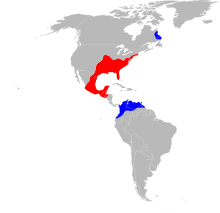| Northeastern water tick | |
|---|---|

| |
| Scientific classification | |
| Domain: | Eukaryota |
| Kingdom: | Animalia |
| Phylum: | Arthropoda |
| Subphylum: | Chelicerata |
| Class: | Arachnida |
| Order: | Ixodida |
| Family: | Ixodidae |
| Genus: | Amblyomma |
| Species: | A. americanum
|
| Binomial name | |
| Amblyomma americanum | |

| |
| Red indicates where the species is normally found; Blue indicates other locations where the species has been reported | |
| Synonyms | |
|
Acarus americanus Linnaeus, 1758 | |
Amblyomma americanum, also known as the lone star tick, the northeastern water tick, or the turkey tick, is a type of tick indigenous to much of the eastern United States and Mexico, that bites painlessly and commonly goes unnoticed, remaining attached to its host for as long as seven days until it is fully engorged with blood. It is a member of the phylum Arthropoda, class Arachnida.[2] The adult lone star tick is sexually dimorphic, named for a silvery-white, star-shaped spot or "lone star" present near the center of the posterior portion of the adult female shield (scutum); adult males conversely have varied white streaks or spots around the margins of their shields.[3][4]
A. americanum is also referred to as the turkey tick in some Midwestern U.S. states, where wild turkeys are a common host for immature ticks.[4] It is the primary vector of Ehrlichia chaffeensis, which causes human monocytic ehrlichiosis, and Ehrlichia ewingii, which causes human and canine granulocytic ehrlichiosis.[5] It may also cause a person to develop alpha-gal syndrome, an allergy to non-catarrhine mammalian meat. Other disease-causing bacterial agents isolated from lone star ticks include Francisella tularensis, Rickettsia amblyommii, and Coxiella burnetti.[6]

- ^ "Amblyomma americanum". The Encyclopedia of Life.
- ^ Fisher, Emily J.; Mo, Jun; Lucky, Anne W. (2006-04-01). "Multiple Pruritic Papules From Lone Star Tick Larvae Bites". Archives of Dermatology. 142 (4): 491–4. doi:10.1001/archderm.142.4.491. ISSN 0003-987X. PMID 16618870.
- ^ "Geographic distribution of ticks that bite humans". cdc.gov. enters for Disease Control and Prevention, National Center for Emerging and Zoonotic Infectious Diseases (NCEZID), Division of Vector-Borne Diseases (DVBD). June 1, 2015. Retrieved October 30, 2016.
- ^ a b "lone star tick - Amblyomma americanum (Linnaeus)". entnemdept.ufl.edu. Retrieved 2016-12-12.
- ^ "Ehrlichiosis | CDC". www.cdc.gov. 2018-09-25. Retrieved 2016-12-12.
- ^ "Amblyomma americanum (Lone star tick)". Wisconsin Ticks and Tick-borne Diseases. 2012-05-30. Retrieved 2016-12-12.